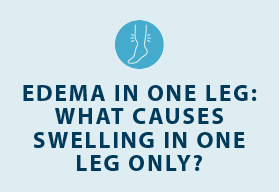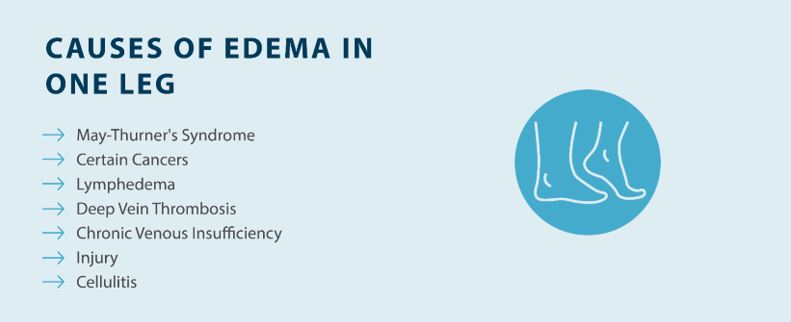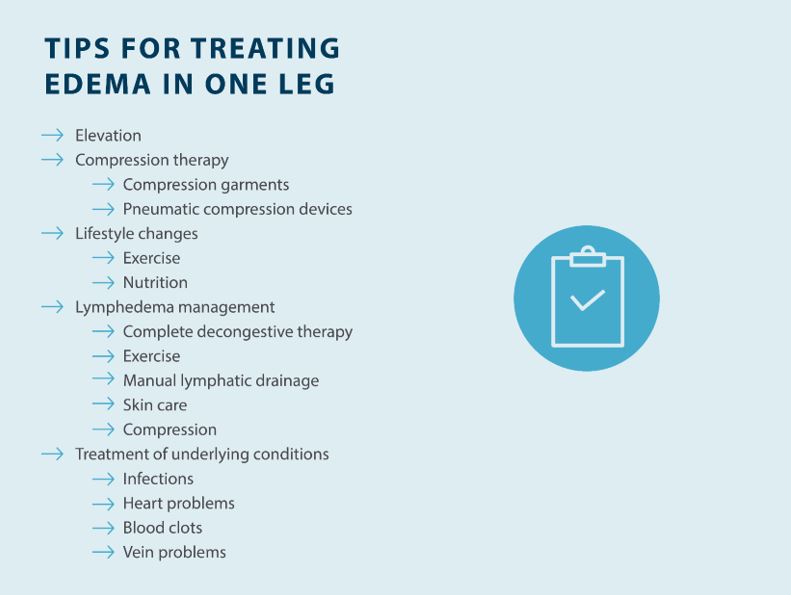Edema in One Leg: What Causes Swelling in One Leg Only?


Edema in One Leg: Causes and Treatment
Edema can affect any part of the body, but in some cases, it may only present itself in one leg. Edema in one leg is typically caused by a localized injury or lymphatic malformation that leads to swelling. Swelling in one leg can cause discomfort and affect your daily life, but getting a diagnosis and treatment plan can help you get relief. Untreated edema can progress and cause several complications. Learn more about the causes of edema in one leg and what you can do to treat it.
What Is Edema?
What Causes Swelling in One Leg Only?
How Can You Treat Edema in One Leg?
Key Takeaways: Edema in One Leg
What Is Edema?
Edema is a medical term for swelling that’s caused by a buildup of fluid that gets trapped in the body’s tissue. While edema usually affects the legs or arms, it can affect any area of the body. Swelling caused by edema can vary in terms of severity, lasting anywhere from a few days to several months or more. Measuring edema allows your doctor or specialist to determine how much your swelling has progressed and create a treatment plan.
Edema has several potential causes, including injury, obesity, and underlying health conditions. This swelling occurs when the blood vessels in your body are damaged, causing them to leak fluid into the nearby tissue, which can result in swelling. If you have symptoms of edema, getting a proper diagnosis is important, as it can help you rule out other potential medical conditions and devise a treatment plan.
What Causes Swelling in One Leg Only?
Swelling caused by edema can be present in both arms or legs at the same time, but in some cases, you can experience edema in one leg. Determining the root cause of your swelling is a key part of treatment, which is why it’s recommended to visit your doctor to get a proper diagnosis. So, what causes swelling in one leg only? Learn more about some of the common edema causes below.

May-Thurner’s Syndrome
May-Thurner’s Syndrome is a vascular condition where the right iliac artery, which is the primary blood vessel in your right leg, compresses on your left iliac artery, which transports blood from your left leg back to your heart. In May-Thurner Syndrome, this compression of the left iliac vein reduces blood flow, which can increase the risk of deep vein thrombosis (DVT), resulting in symptoms like pain, discoloration, and swelling in one leg, typically the left leg. Overall, it’s found that over 20% of the population may be living with May-Thurner Syndrome, but it is often underdiagnosed or not considered in patients with other risk factors.1
Certain Cancers
Another potential cause of edema in one leg is certain types of cancers, such as pelvic cancers or sarcoma. Pelvic cancers, such as ovarian, cervical, or uterine cancers, can impact lymphatic drainage in that area. When tumors obstruct lymphatic vessels or nodes, it can result in lymphedema, where fluids build up in the surrounding tissues due to the lymphatic system’s inability to effectively drain fluid. With pelvic cancers, one of the symptoms can be edema in one leg.2
Sarcoma is another type of cancer that can cause edema in one leg. Sarcoma originates in the body’s connective tissues, such as the bones, tendons, muscles, cartilage, and blood vessels, and can form in any region of the body. With that said, symptoms can vary depending on where the sarcomas are located. For patients with sarcomas in the leg, swelling can occur, as the sarcomas can put pressure on nearby blood vessels or lymphatic vessels, making it difficult for fluid to flow naturally throughout the body. This poor circulation can cause swelling in one leg.3
Lymphedema
Lymphedema is a type of edema that’s caused by built-up fluid in your tissues, unable to be filtered and detoxified by your lymphatic system. In healthy bodies, lymphatic fluid travels through lymph vessels and nodes before returning to the bloodstream, but lymphatic dysfunction can cause fluid to pool up in the affected area.4
There are several potential causes of lymphedema, including cancer, cancer surgery, and radiation therapy. Lymphedema can also be caused by genetics, and it shares several risk factors — such as obesity and chronic venous insufficiency — with edema. Lymphedema that’s caused by genetics is known as primary lymphedema, while lymphedema caused by an acute injury, disease, cancer, or medication is called secondary lymphedema.
Because lymphedema is a result of lymphatic dysfunction, it can affect one small area where the lymphatic system is damaged. It’s not uncommon for lymphedema to cause edema in one leg, and you may notice pitting edema and other similar symptoms.
Deep Vein Thrombosis
Deep vein thrombosis (DVT) is a blood clot deep in your circulatory system. You have superficial veins and deep veins, and the deep veins are responsible for transporting larger volumes of blood. When a clot forms in one of these deep veins, it’s known as DVT.
DVT is a serious medical condition that can be life-threatening and have lasting effects. Because blood clots create a blockage in your veins, they can cause fluid to pool up into the tissues and can lead to swelling. This swelling commonly occurs in one leg because that’s where the clot is located.
If you’re at high risk for blood clots, you should talk to your doctor about preventing DVT. Edema in one leg is one of many serious side effects of DVT.
Chronic Venous Insufficiency
Chronic venous insufficiency (CVI) is a venous disease that affects the valves inside your veins. Veins have interior valves that help transport blood back to your heart against the flow of gravity, but blood can pool up if these valves aren’t working properly. In some cases, DVT may cause lasting damage that leads to CVI.
If the valves in one leg are damaged, you may have edema in one leg as a result. CVI can progress over time and lead to several other conditions, including pitting edema in one leg.
CVI commonly results in dependent edema, which is edema that occurs in a part of the body that’s affected by gravity. When the valves inside the veins in your legs are damaged, it can be difficult to keep blood from pooling in your lower extremities.
Injury
Certain types of injuries can cause edema in one leg, especially severe injuries that don’t heal quickly. Edema caused by injuries typically subsides as the injury heals, but it can last longer if the injury causes long-term damage to your veins or lymphatic system.
Several types of injuries can lead to edema, including burns, infections, deep cuts, and severe blunt trauma. If you have a serious injury, it’s always recommended to schedule an appointment with your doctor and get it assessed and treated.
Cellulitis
Cellulitis is a type of infection that affects the deeper layers of your skin, including the dermis and the layers beneath it. Because cellulitis occurs in deeper skin layers, it can impact other parts of your body, including your lymphatic system and muscle tissue.
When cellulitis damages deeper layers of the skin, it can lead to subcutaneous edema. This type of edema can cause damage to the blood vessels and nerves that are beneath your skin.
Keep in mind that subcutaneous edema is linked to several medical conditions, so it’s best to get a diagnosis from a professional to rule out serious conditions.
How Can You Treat Edema in One Leg?
Edema in one leg can be an obstacle in daily life, causing pain and discomfort and making simple tasks more difficult. Fortunately, there are ways to manage swelling and prevent complications. Here are some of the actions you can take to reduce swelling caused by edema in one leg:

- Elevation: Elevating swollen limbs can provide relief from swelling by guiding fluid away from the swollen area. Elevation is an effective treatment method for various types of edema, including lymphedema.
- Compression therapy: Compression therapy involves using compression garments — which your doctor can prescribe — and compression devices to reduce swelling. Pneumatic compression devices like the Flexitouch Plus System from Tactile Medical provide at-home relief.
- Lifestyle changes: Simple lifestyle changes can help you get relief from edema in one leg. Exercising, eating a healthy diet, and avoiding sitting or standing for long periods can provide noticeable relief from swelling. Your doctor may recommend a diet for edema that includes less salt and fewer caffeinated and alcoholic beverages.
- Lymphedema management: If your swelling is caused by lymphedema, there are several lymphedema management options you can focus on. Complete decongestive therapy (CDT) combines exercise, manual lymphatic drainage, skin care, and compression to provide relief from swelling.
- Treatment of underlying conditions: Treating the underlying cause of your edema is a crucial part of managing swelling. If your edema is caused by an infection, blood clot, heart problem, or vein problems, you should focus on treating that underlying condition.
Key Takeaways: Edema in One Leg
Edema can lead to pain and discomfort, but you have options. Understanding the potential causes of edema in one leg and making lifestyle changes to prevent it can help you live a healthy life without swelling.
If you’re having trouble finding relief from swelling, Tactile Medical can help. The Nimbl System and Flexitouch Plus System use pneumatic compression to provide targeted relief for edema and lymphedema patients, and you can use it at home. You can also choose between different models to target different parts of your body. Contact Tactile Medical to learn more about the Nimbl System and Flexitouch Plus System today.
References
1. Peters M, Syed RK, Katz M, Moscona J, Press C, Nijjar V, Bisharat M, Baldwin D. May-Thurner syndrome: a not so uncommon cause of a common condition. Proc (Bayl Univ Med Cent). 2012 Jul;25(3):231-3. https://www.ncbi.nlm.nih.gov/pmc/articles/PMC3377287/
2. Symptoms of Advanced Cancer. Cancer Research UK. https://www.cancerresearchuk.org/about-cancer/cervical-cancer/advanced/symptoms
3. NHS Inform. Soft tissue sarcomas: Teenagers and young adults. NHSInform.scot. https://www.nhsinform.scot/illnesses-and-conditions/cancer/cancer-types-in-teenagers-and-young-adults/soft-tissue-sarcomas-teenagers-and-young-adults/
4. Lymphedema (PDQ®)–Patient Version. National Cancer Institute. Accessed September 11, 2023
https://www.cancer.gov/about-cancer/treatment/side-effects/lymphedema/lymphedema-pdq